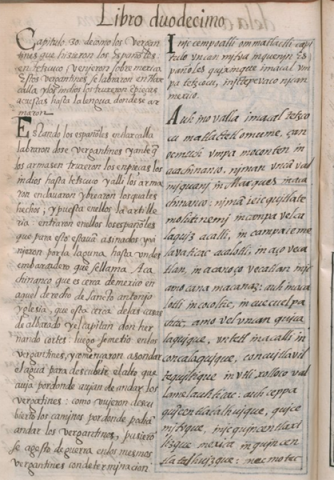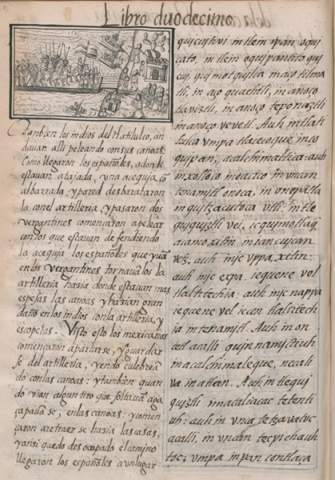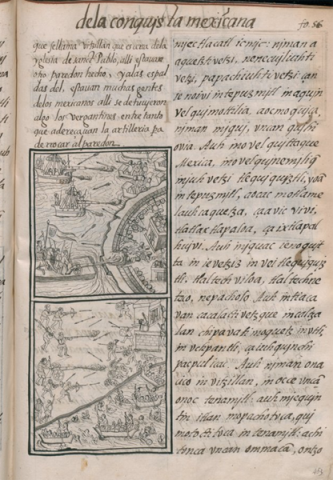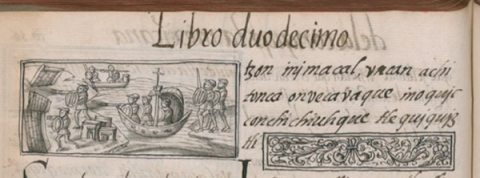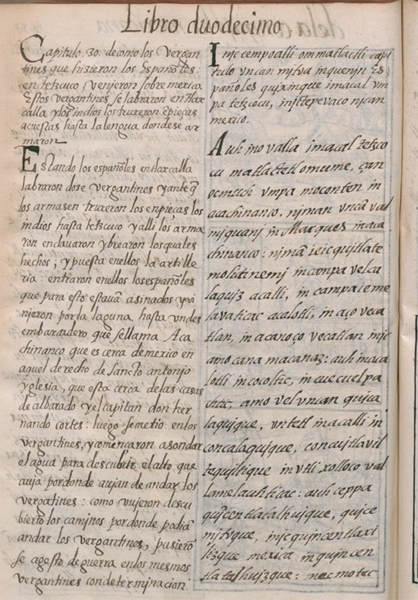 |
[Transcription of the Nahuatl (right-hand column) by James Lockhart:]
[f. 54v.] Inic cempoalli ommatlactli capitulo vncan mitoain quenin Españoles quixinque imacal vmpa tetzcocu, inic tepevaco nican mexico.
Auh in ovalla imacal tetzcocu matlactetl omume, çan oc much vmpa mocenten in acachinanco, niman vncā valmiquani in Marques in acachinanco: nimā ie ic quitlatemolitinemi in campa vel calaquiz acalli, in campa iemelavaticac acalotli, in aço vecatlan, in acanoço vecatlan inic amo cana macanaz: auh in acalotli in cocoltic, in cuecuelpachtic, amo vel vncan quicalaquique,
vntetl in acalli in concalaquique, concuitlaviltequiltique in vtli xolloco vallamelauhticac: auh ceppa quīcentlatalhuique, quicemitoque, inic quincentlaxilizque mexica in quincentlatalhuizque: nec motec
|
[Translation of the Nahuatl (right-hand column) by James Lockhart:]
Thirtieth chapter, where it is said how the Spaniards constructed boats in Tetzcoco in order to come to make a conquest here in Mexico.
When their twelve boats had come from Tetzcoco, at first they were all assembled at Acachinanco, and then the Marqués moved to Acachinanco. He went about searching where the boats could enter, where the canals were straight, whether they were deep or not, so that they would not be grounded somewhere. But the canals were winding and bent back and forth, and they could not get them in.
They did get two boats in; they forced them down the road coming straight from Xoloco. Once they had a general consultation and decided to send their whole force against the Mexica. Then they lined themselves up,
[Translation of the Spanish (left-hand column) by James Lockhart:]
Chapter Thirty, of how the brigantines that the Spaniards made in Tetzcoco came against Mexico. These brigantines were built in Tlaxcala, and the Indians carried them in pieces on their backs to the lake, where they were assembled.
While the Spaniards were in Tlaxcala, they built twelve brigantines, but before assembly the Indians carried them in pieces to Tetzcoco, and there they assembled them, nailing them together and caulking them. When they had been finished and the artillery placed in them, the Spaniards assigned to them boarded and came by the lake to a landing place called Acachinanco, which is close to Mexico, in the vicinity of the church of San Antonio, close to the houses of Alvarado. Then Captain don Hernando Cortés went into the brigantines, and they began to sound the water to discover the depth where the brigantines would have to go.
When they had found ways by which the brigantines could go, they took a warlike stance in these brigantines, determined
|
[Translation of the Nahuatl into Spanish by Fr. Bernardino de Sahagún; transcription of the Spanish (left-hand column) by James Lockhart:]
[f. 54v.] Capitulo .30. de como los vergantines que hizieron los Españoles: en Tetzcuco, venieron sobre mexico. Estos vergantines se labraron en Tlaxcalla y los indios los truxeron ē pieças a cuestas hasta la lengua* donde se armaron
Estando los españoles en tlaxcalla labraron doze vergantines y ante q̄ los armasen truxeronlos en pieças los indios hasta tetzcuco y alli los armaron enclauaron y brearon los quales hechos; y puesta en ellos la artilleria: entraron en ellos los españoles que para esto estauā asinados y vinieron por la laguna hasta vn desembarcadero que se llama Acachinanco que es cerca de mexico en aquel derecho de Sancto antonio yglesia,** que esta cerca de las casas de albarado y el capitan don hernando cortes: luego se metio en los vergantines, y començaron a sondar el agua para descubrir el alto que auia por donde auian de andar los vergantines:
como vuieron descubierto los caminos por donde podiā andar los vergantines, pusierōse a gesto de guerra en los mesmos vergantines con determinacion
----------
*LENGUA. Presumably "laguna" is intended, but conceivably the meaning could be a strip of land running out into the water.
**EN AQUEL DERECHO DE SANCTO ANTONIO YGLESIA. The syntax of the Spanish is heavily influenced by Nahuatl here.
|
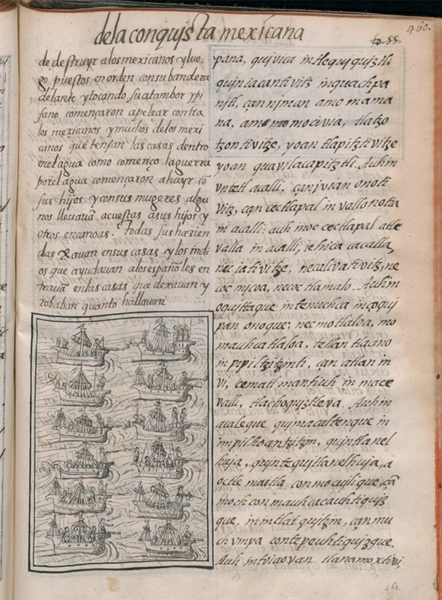 |
[Transcription of the Nahuatl (right-hand column) by James Lockhart:]
[f. 55r.] pana, quivica in tlequiquiztli quiniacantivitz in quachpanitl, çan niman amo mamana, amo momocivia, tlatzotzontivitze, yoan tlapitztivitze yoan quavilacapitztli.
Auh in vntetl acalli, çan ivian onotivitz, çan cectlapalin vallonotia in acalli: auh in oc cectlapal atle valla inacalli, iehica ca calla, nec iativitze, necalivativitz, necoc micoa, necoc tlamalo. Auh in oquittaque in tenuchca inçoquipan onoque: nec motlaloa, momauhcatlaloa, tetlantlaano in pipiltzitzinti, çan atlan in vi, cematl mantiuh in macevalli, tlachoquiztleva. Auh in acaleque quimacaltenque in impilhoantzitzin, quintlanelhuia, quintequitlanelhuia, aoc tle ma itla conmocuiliquintlatquitzin, çan much vmpa contepeuhtiquizque. Auh in toiaovan tlanamoxtivi, |
[Translation of the Nahuatl (right-hand column) by James Lockhart:]
carrying the guns. A cotton banner came ahead. They were not at all excited or perturbed. They came beating drums and blowing [trumpets] and wooden fifes.
And the two boats came gradually, keeping on one side. On the other side no boats came, because there were houses there. They came ahead, fighting as they came; there were deaths on both sides, and on both sides captives were taken. When the Tenochca who lived in Çoquipan saw this, they fled, fled in fear. The little children were taken along with the others. They just went into the water; the water was full of people, and a wail arose. And those with boats put their children in them and poled them along, working vigorously. They took nothing at all with them, they just left all their poor property in fear, they just scattered everything in their haste. And our enemies went snatching things up,
[Translation of the Spanish (left-hand column) by James Lockhart:]
to destroy the Mexica. Then, arranged in order, with their banner at the front and playing their fife and drum, they began to fight against the Mexica.
When the battle began on the water, many of the Mexica who had their houses in the water began to flee with their wives and children. Some carried their children on their backs, others in canoes. They left all their belongings in their houses, and the Indians who were helping the Spaniards went into the houses they had left and stole whatever they found.
|
[Translation of the Nahuatl into Spanish by Fr. Bernardino de Sahagún; transcription of the Spanish (left-hand column) by James Lockhart:]
[f. 55r.] de destruyr a los mexicanos y luego puestos en orden con su bandera delante y tocando su atambor y pifano començaron a pelear contra los mexicanos
y muchos de los mexicanos que tenian las casas dentro en el agua como començo la guerra por el agua començaron a huyr cō sus hijos y con sus mugeres algunos lleuauā a cuestas a sus hijos y otros en canoas. Todas sus haziendas xauan* en sus casas y los indios que ayudauan a los españoles entrauā en las casas que dexauan y robaban quanto hallauan
----------
*XAUAN. For "dexauan."
|
 |
[Transcription of the Nahuatl (right-hand column) by James Lockhart:]
[f. 55v.] quicuitivi in tlein ipan oquiçato, in tlein oquipantito quicui, quimotquilia in aço tilmatli, in aço quachtli, in anoço tlaviztli, in anoço teponaztli in anoço vevetl.
Auh in tlatilulca vmpa tlaiecoque in çoquipan, acalchimaltica: auh in xolloco in oacico in vncan tenamitl onoca, in onepātla in quitzacutoca vtli: in tlequiquiztli vei, ic quimotlaq̄, aiamo xitin in iancuican vetz; auh inic vppa, xitin: auh inic expa, iequene vel tlaltitech ia: auh inic nappa ie quene vel ic cen tlaltitech ia in tenamitl.
Auh in ontetl acalli quinnamictiuh in acalchimaleque, necaliva in atlan. Auh in tlequiquiztli imacaliacactetentiuh: auh in vnca tetzavatoc acalli, in vncan tecpichauhtoc; vmpa inpan contlaça
|
[Translation of the Nahuatl (right-hand column) by James Lockhart:]
taking whatever they came upon. Whatever they hit on they carried away, whether cloaks, lengths of cotton cloth, warriors’ devices, log drums, or cylindrical drums.
The Tlatelolca fought in Çoquipan, in war boats. And in Xoloco [the Spaniards] came to a place where there was a wall in the middle of the road, blocking it. They fired the big guns at it. At the first shot it did not give way, but the second time it [began to] crumble. The third time, at last [parts of] it fell to the ground, and the fourth time finally the wall went to the ground once and for all.
And the two boats [of the Spaniards] went along contending with the war boatmen; there was skirmishing in the water. A gun went in the prow of each of their boats, and where the [Mexica] boats were close together and assembled, they fired on them;
[Translation of the Spanish (left-hand column) by James Lockhart:]
Also the Indians of Tlatelolco went about there fighting with their canoes. When the Spaniards reached the place where a canal was blocked with a barricade or wall, they knocked it down with the artillery.
Two brigantines went through and began to fight with those who were defending the canal. The Spaniards who were in the brigantines aimed the artillery at where the canoes were thickest; they did great damage to the Indians with the artillery and muskets.
Seeing this, the Mexica began to draw back and protect themselves from the artillery, going zigzagging with the canoes, and also when they saw that they were about to fire one of the cannon, they crouched down in the canoes. They began to retreat toward the houses, so that the road was left empty.
The Spaniards reached a place
|
[Translation of the Nahuatl into Spanish by Fr. Bernardino de Sahagún; transcription of the Spanish (left-hand column) by James Lockhart:]
[f. 55v.] [Aquí: un dibujo]
Tanbien los indios del tlatilulco, andauan alli peleando con sus canoas: Como llegaron los españoles, adonde estauan atajada, vna acequia cō albarrada, y pared desbarataronla con el artilleria,
y pasaron dos vergantines començaron a pelear con los que estauan defendiendo la acequia los españoles que yuā en los vergantines tornauālos la artilleria hazia donde estauan mas espesas las canoas y hazian gran daño en los indios con la artilleria, y escopetas.
Visto esto los mexicanos començaron apartarse, y a guardarse del artilleria, yendo culebreādo con loas canoas: y tambien quando vian algun tiro que soltauā agaçapauāse, en las canoas: y començaron a retraerse hazia las casas, y ansi quedo desocupado el camino
llegaron los españoles a vn lugar
|
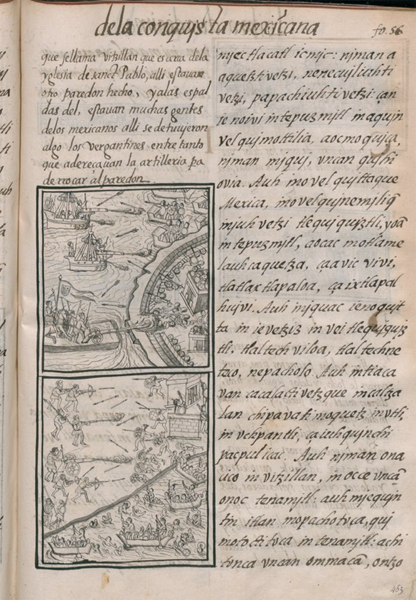 |
[Transcription of the Nahuatl (right-hand column) by James Lockhart:]
[f. 56r.] miec tlacatl ic mic: niman aaquetztivetzi, nenecuiliuhtivetzi, papachiuhtivetzi: can ie no ivi in tpuzmitl in aquin vel quimottilia, aocmo quica, niman miqui, vncan quihiovia.
Auh in o vel quittaque Mexica, in o vel quinemiliq̄ in iuh vetzi tlequiquiztli, yoā in tepuzmitl, aocac motla-melauhcaquetza, ça avic vivi, tlatlaxtlapaloa, ça ixtlapalhuivi. Auh in iquac ie no quitta in ie vetziz in veitlequiquiztli, tlaltech viloa, tlaltech neteco, nepacholo. Auh in tiacavan cacalactivetzque in caltzalan chipavatimoquetz in vtli, in vchpantli, ça iuhquin chipacpul icac.
Auh niman onacico in vitzillan, in oc ce vncā onoc tenamitl: auh miequintin itlan mopachotoca, quimotoctitoca in tenamitl: achitonca vncan ommacā, ontzo
|
[Translation of the Nahuatl (right-hand column) by James Lockhart:]
many people died from it. [When hit, each boat] quickly lifted its prow, wavered, and sank. Likewise, when they took aim at someone with the iron bolts, he did not escape; immediately he died, he expired.
But when the Mexica had been able to see and judge how the guns hit, or the iron bolts, they no longer went straight, but went back and forth, going from one side to the other, zigzagging. Also, when they saw the big gun was about to go off, everyone hit the ground, spread out on the ground, crouched down, and the warriors quickly went in among the houses. The road cleared off; the highway was as if swept clean. Then [the Spaniards] reached Huitzillan, where there was another wall. Many [Mexica] lay crouching at it, hiding behind the wall. For a little while [the Spaniards’] boats were grounded.
[Translation of the Spanish (left-hand column) by James Lockhart:]
called Huitzillan, which is near the church of San Pablo. Another barrier had been erected there, and behind it were many of the Mexica. The brigantines halted there for a time while they adjusted the artillery to knock down the barrier.
|
[Translation of the Nahuatl into Spanish by Fr. Bernardino de Sahagún; transcription of the Spanish (left-hand column) by James Lockhart:]
[f. 56r.] que se llama vitzillan que es cerca de la yglesia de sanct Pablo, alli estaua otro paredon hecho, y a las espaldas del, estauan muchas gentes de los mexicanos alli se detuuieron algo los vergantines entre tanto que adereçauan la artilleria pa derrocar al paredon.
|
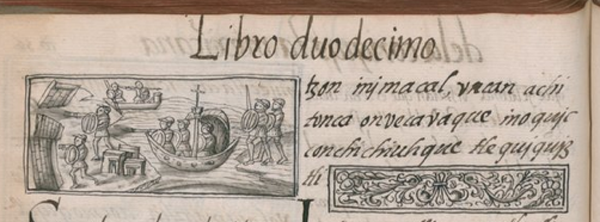 |
[Transcription of the Nahuatl (right-hand column) by James Lockhart:]
[f. 56v.] tzon in imacal, vncan achitonca onvecavaque in oquicconchichiuhque tlequiquiztli.
|
[Translation of the Nahuatl (right-hand column) by James Lockhart:]
They were there for a short time while they adjusted the guns.
[Translation of the Spanish (left-hand column) by James Lockhart:]
(intentionally blank)
|
[Translation of the Nahuatl into Spanish by Fr. Bernardino de Sahagún; transcription of the Spanish (left-hand column) by James Lockhart:]
f. 56v., la parte de arriba; un dibujo; sin texto en español]
|
